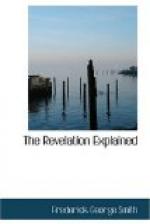This head, however, continued only “a short space”; and an eighth arose on Christmas, the first day of the year 800 (as time was then reckoned), when Charlemagne was crowned emperor of Rome, and thus revived the empire of the West. This eighth head, however, was “of the seven”; for it was the same as the sixth, both being Imperial—the first being in the Augustan line, and the other in the Carlovingian, and separated from each other by the seventh, or Patriciate. Considered one way, there were eight heads, but two of them were alike, hence only seven; for the eighth was of the seven. According to verse 11 it was under the eighth head that the beast subsisted at the time he was carrying the woman of this chapter, which exactly accords with the historical facts in the case; and the same was continued in a line of emperors reaching down to the time of the French Revolution.
The ten horns had “received no kingdom as yet.” This signifies that at the time when the Revelation was given they had not yet arisen. When they did come into existence they were to receive power as kings with the beast and were to give to it their power and strength. It is a singular fact that a distinct head should continue to exist after these horns had arisen and developed into powerful kingdoms; but herein the remarkable accuracy of prophecy is clearly shown. It is said that they should make war with the Lamb and that the Lamb should overcome them. Some think that this has reference to the persecution of the saints during the Dark Ages; but it seems to me that it would have been stated differently if such were its meaning. It may be a prophetical reference to the battle of Armageddon, which will be terminated by the coming of the Son of God himself to overthrow completely all the powers of wickedness.
15. And he saith unto
me, The waters which thou sawest, where
the whore sitteth, are peoples,
and multitudes, and nations, and
tongues.
16. And the ten horns
which thou sawest upon the beast, these
shall hate the whore, and
shall make her desolate and naked, and
shall eat her flesh, and burn
her with fire.




